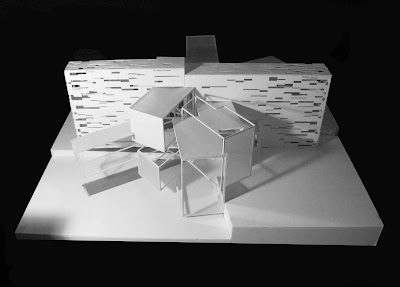 By Ron Eckels
By Ron EckelsWho is truly critical of architecture in our present times? Theory and criticism are not the going trends amidst an assortment of ‘objects’, which mark the various extremes of architectural destitution today as determined by programs and relative skill. In our schools we are taught to make things look good or cool with not true understanding of what either of these words ever mean and of course we in no way delve into the actual being of cool or good. Why should we? In a period dominated by shallow understandings of sensation, affect, atmosphere, ornament and form any one of those things could be used as a suitable fallback for a destitute project that twists and swirls and swallows itself into an infitismally haphazard complexity that leaves both producer and critic without a clue as to what, how or more importantly, why it should be. We are wholly preoccupied by perception and, more indiscreetly and unabashedly, deception. The process of looking cool or good bears little to no meaning in an environment manifested out of true and rich informational matter; this matter being tangible or otherwise (yes, I don't even wish to insult our imaginations by acquitting to it the anemic 'architecture' that marks our times, or rather the walls of architectures of another time) and this environment being of course our universe
We lack crucial amounts and conditions of substance in today's architecture and focus solely on 'form', in the philosophical sense of the word, an arbitrary marker which ironically or coincidentally, probably both, is displayed through current architectural forms. and most of these forms lack any subset of formal substance. Its anemic straight to the bone marrow. As students of architecture (here I’m talking from my generation) are we called to anything or are we left devoid of vocation and PURPOSE. We long for a reality to possess and guide, so much really that we throw ourselves into a false truth that is not even suitable for the real of virtual environments.
I went into an analogy that stemmed from my experiences this week at the sciarc intro class which basically was a frenzied death race to one up everyone around us that we simply all went for the biggest bang we could becoming so engrossed in the programs we lost all other interest in reasons for why a flower plan does not need technical lines, that a flower a should be treated as such and drawn as such. We will be lost all semester possibly because we just brainwashed with maya. Basically though what this leads to in all generations and beyond just the maya frenzy is an irreverence which isn't fit for a revolutionary field, take Hernan for example, while his work looks interesting and has all this thought behind it, his philosophy and attitude about oh I don't need to build shit or do anything with my architecture is flat out BULLSHIT. I compare him to non-conformists when they stopped actually being non-conformists, like when the crazy Goth kid at school stops not fitting in so his bad attitude and Emo dramatics are just annoying and best ignored.
Summed it up as:
We lack purpose
We lack an understanding of architecture as a verb, not a noun, as discernment which produces other nouns and verbs, called acts of architecture, buildings or the activities of the world, etc
We are not taught anything in school
We are not worldly, impassioned or critical of ourselves
We must begin by being critical of our education
We must then be critical of our profession
We then must finally turn a critical eye to the world, recognizing the possibilities of all things (Deleuze) and recognize architecture as discernment of this infinite multiplicity to be executed with care, precision and judgment (sound or otherwise, intelligent erratcism is essential to our progression--look at archigram and jimenez)
Architecture requires purpose beyond itself,


















































